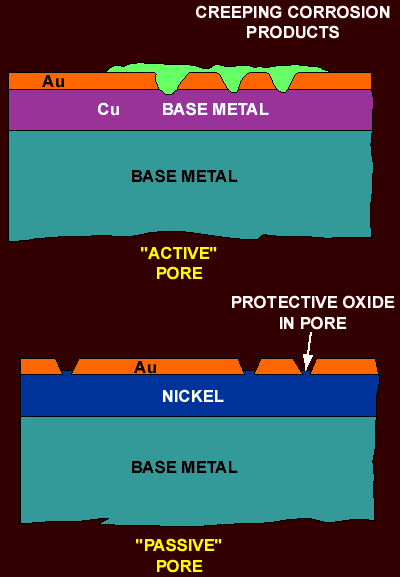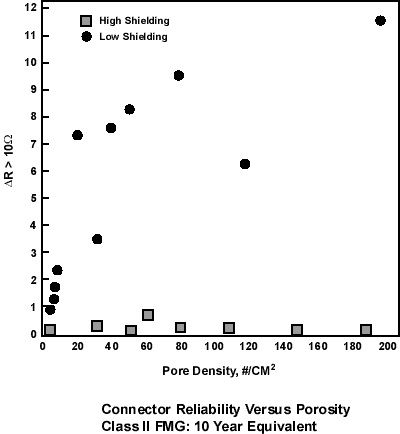Porosity is a result of discontinuities that expose the underplate or base metal. Porosity originates during the manufacturing process and are a result of:
- Substrate Surface Defects
- Unclean Plating Solutions
- Internally Stresses Deposits
- Thickness of the Prime Plate
- Process Variables
Porosity is predominately a concern with gold plated surfaces. There are two types of pores, active or passive. An active pore is one which penetrates through the gold or gold/nickel to the base metal. These pores will allow corrosion products to exit and spread on the contact surface. The passive pores usually are found when gold is plated over nickel. The pore site penetrates the gold to the nickel. The nickel in the pore site oxidizes. Since nickel oxides form to a thickness >1 microinch, and is self limiting, no adverse reaction will occur as long as the gold plating is thicker and gross porosity does not exist.
 Figure 9. Porosity and Corrosion
Figure 9. Porosity and CorrosionPore sites are generally small and cannot be observed under normal magnification. If the mating contact rest on a pore site and is still contacting the gold surface through other 'a' spots, it will still function properly. The number of pores that should be allowed is argumentative. In a harsh envrionment, active pores are a concern. If the pore sites are exposed to the environment in an unmated state, then pore corrosion may result (base metal pores—active).
If on the other hand, the connectors are mated and are well shielded from the environment, they will function without degradation. The figure below indicates the performance of contact surfaces with varying degress of porosity and the percent of observations in excess of a 10 milliohm change. Two cases are involved. The first is with contacts having low shielding such as "stick" headers, open designs (card edge connectors, etc.) which allow the contacts a more direct exposure to the environment. The second case illustrates a well protected contact via the use of shrouds and/or are well recessed in their housings. In essence in the second instance the harsh environment does not get to the contact areas and does not react. Thus porosity as a potential failure mechanism is dependent on:
- Location of the pore sites.
- Shielding features, shrouding, closed design.
- Passive or active pores.
 Figure 10. Connector Reliability versus Porosity
Figure 10. Connector Reliability versus Porosity